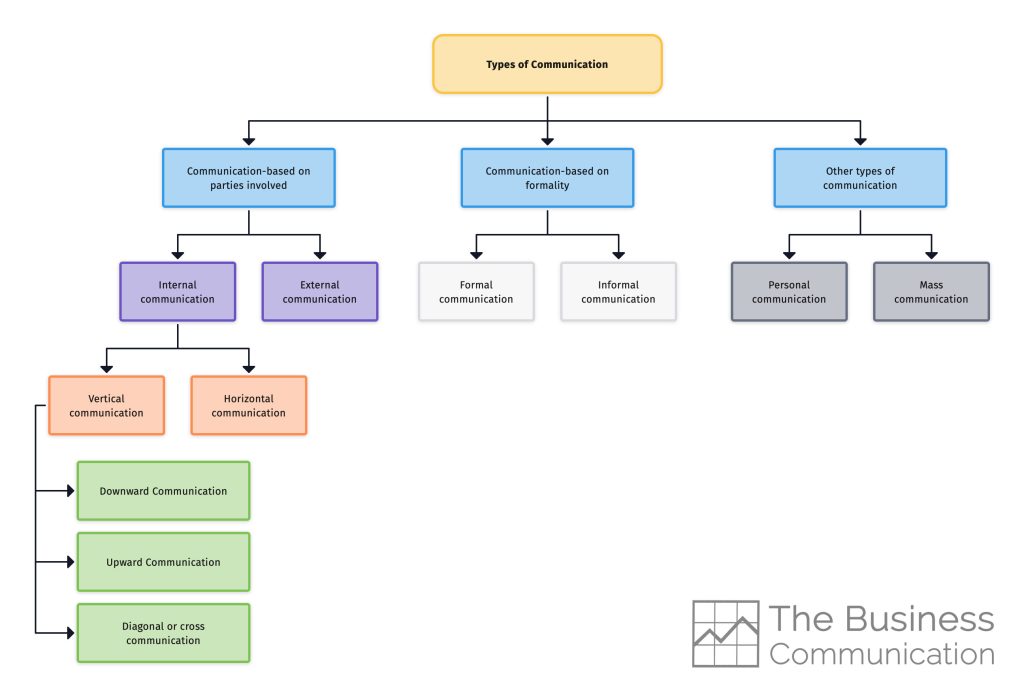Communication is the exchange of information, news, ideas, feelings, and views between persons. In the process of communication, information flows from sender to receiver. Organizations are mainly concerned with two types of communication.
These are internal communication and external communication. Internally, communication occurs horizontally and vertically. Moreover, these communications may occur formally and informally. The following diagram shows the various types of communication:
Types of Business Communication

A. Communication-based on parties involved
Communication is mainly two types on the basis of parties involved in the communication process. These are internal communication and external communication.
- Internal communication: Internal communication refers to the flow of information to the internal participants of an organization. It happens only within the organization. The main purpose of this communication is to ensure smooth functioning of organizational activities. Internal communication may be of two types: Vertical communication and horizontal communication.
- Vertical communication: When information flows between superiors and subordinates of an organization, it is known as vertical communication. Vertical communication can be of three types: Downward communication, upward communication and diagonal communication.
-
- Downward Communication: Downward communication occurs when information flows form superiors to subordinates. Through downward communication, superiors send organizational goals, policies, job assignments, orders, instructions etc to their subordinates.
- Upward Communication: Upward communication occurs when information flows form subordinates to superiors. Through upward communication, subordinates convey their responses, reactions and performance feedback to their superiors.
- Diagonal or cross-communication: Diagonal communication occurs when information flows between persons at different levels who have no direct reporting relationships. Diagonal communication is used to speed information flow, to improve understanding and to coordinate efforts for the achievement of organizational goals.
-
- Horizontal communication: When information flows among persons holding the same position or rank in the organization, it is called horizontal communication.
- Vertical communication: When information flows between superiors and subordinates of an organization, it is known as vertical communication. Vertical communication can be of three types: Downward communication, upward communication and diagonal communication.
- External communication: When an organization communicates with external or outside parties, it is called external communication. External parties include customers, suppliers, investors, bankers, insurance companies, government agencies, local communities etc. the main purpose of external communication is to exchange information with the outside parties.
B. Communication-based on formality
Communication can be classified on the basis of formality into two types: formal communication and informal communication.
- Formal communication: When communication occurs by following the prescribed rules and procedures of the organization, it is called formal communication. Formal communication is governed by the established chain of command.
- Informal communication: When communication does not follow any prescribed rule or procedure, it is called informal communication. The basis of informal communication is spontaneous relationship among the participants. Informal communication is sometimes more powerful and more effective that formal commutation.
C. Other types of communication:
There are two other useful types of communication. These are as follows:
- Personal communication: When people exchange information related to their personal lives or personal affairs, it is called personal communication. Every person engages himself or herself in personal communication. Personal communication occurs among the parties within the organization and outside the organization.
- Mass communication: Mass communication is a process of transmitting messages to a large number of scattered audiences. Through mass communication, information can be transmitted quickly to a large number of people who generally stay far away form the sources of information. Mass communication is done through radio, television, newspaper, magazine, leaflets etc.



5 Comments
Correctly done .This is wonderful
Very interesting
its perfect
what about intra personal communication?? is it still classification?
what a very rich, up-to-date lecture! l really appreciate it.